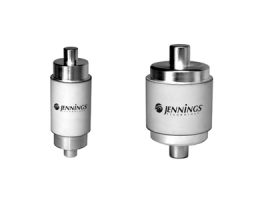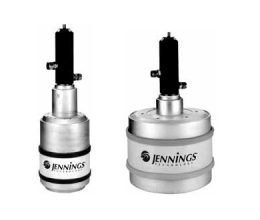Jennings Vacuum Capacitors
A vacuum capacitor is a capacitor which uses vacuum as dielectric instead of air or other insulating materials. The vacuum dielectric allows a higher voltage rating that an air dielectric.
Jennings Vacuum capacitors
A typical Jennings vacuum capacitor consists of two sets of concentric cylinder plates, one adjustable and the other fixed, are enclosed in an evacuated ceramic envelope with OFHC copper seals at both ends. A flexible metal bellows, attached to a sleeve-type bearing, maintains vacuum while allowing capacitance to vary.
The linear sliding motion required to vary capacitance is converted to rotary tuning via an adjustment screw; in many capacitors, direct pull tuning is an alternative. Internal breakdown voltage is primarily determined by the spacing of the opposing plates and a high vacuum level.
The following are general specifications pertaining to Jennings vacuum capacitors. Current ratings are for normal convection cooling in ambient temperature of 25 °C unless otherwise specified.
- Maximum allowable operating temperature — 125 °C (257 °F) for ceramic capacitor
- Cooling — natural convection unless otherwise specified
- Mounting position — any
- Rotation to increase capacity — counterclockwise
If none of our standard catalog models meet your needs, our engineers will work with you to design a custom solution to meet your specific needs.
Features
- High voltage rating
- High current rating
- Wide tuning ranges
- Low losses
- Self-healing
- High altitude operation

Fixed vacuum capacitors
Fixed vacuum capacitors are available with capacitances of 25 to 2,000 pF, withstanding working voltages at 50/60 Hz in the range of 4.5 to 33 kV.

Variable Vacuum Capacitors
Variable vacuum capacitors are available with capacitances of 30 to 4,000 pF, withstanding voltages at 50/60 Hz in the range of 1.8 to 36 kV.